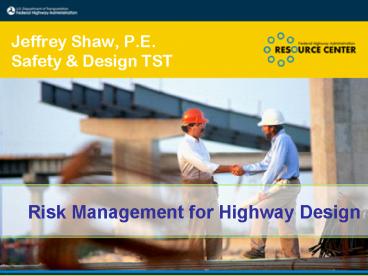Risk Management for Highway Design - PowerPoint PPT Presentation
1 / 24
Title:
Risk Management for Highway Design
Description:
Risk Management Test for Design. Does your agency have adequate and ... framework for risk analysis and evaluation to support decision-making processes? ... – PowerPoint PPT presentation
Number of Views:76
Avg rating:3.0/5.0
Title: Risk Management for Highway Design
1
Risk Management for Highway Design
- Jeffrey Shaw, P.E.
- Safety Design TST
2
(No Transcript)
3
RISK
- A factor, element, or course involving
uncertainty regarding harm, loss, danger or damage
4
Risk Management Test for Design
- Does your agency have adequate and dynamic
processes in place to identify existing and new
risks faced? - Does your agency have the right balance of
arrangements in place to deal with these risks? - Does your agency have an adequate framework for
risk analysis and evaluation to support
decision-making processes?
Source "Guide to Risk Assessment and Allocation
for Highway Construction Management",
FHWA-PL-06-032
5
Risk Management Characteristics
- Explicitly addresses uncertainty
- Based on the best available information
- Part of the decision-making process
- Systematic, structured, and an integral part of
organizational processes - Dynamic, iterative, responsive to change, and
capable of continual improvement and enhancement - Accounts for human factors
- Transparent and inclusive
6
Risk-oriented Highway Design
- Not a new concept
- May involve different approaches and viewpoints
- Who or what is at risk and what is the core
motivation - Safety of Facility Users (i.e. motorists,
pedestrians, etc.)? - Road Agency (tort liability concerns)?
- Underlying theme is addressing the risk
- Implication is that relying solely on standards
does not guarantee a facility free of risk - Identifying/defining the risk is essential for
managing the risk
7
Fundamental Aspects
- Understanding Design Risk involves
- Knowing the basis and assumptions underlying the
standards - Defining the conditions of the project
- Physical
- Traffic
- Safety
8
Identify Characterize the Degree of Risk
- What are the variables that influence Risk?
- Exposure
- Traffic Volume
- Location
- Duration
- Deviation from Nominal
- Degree of variance
- Severity of Outcome
- Possible worst-case scenario
9
Assessing Design Risks
- Assessing the probability and severity of adverse
consequences associated with activities,
recommendations or designs. - Does not need to be a complicated quantitative
assessment, but rather a practical assessment
based on experience, engineering judgment and
historical standard of practice. - To the extent possible, risks should be
quantified, both on the basis of their potential
probability and for their potential consequences.
10
Risk-based Safety Analysis Tools
- Safety Effects Studies
- horizontal alignment
- vertical alignment
- cross-section
- intersections
- IHSDM (ihsdm.org)
- Includes crash prediction, design consistency and
capacity calc - Highway Safety Manual
11
Risk-based Safety Analysis Tools
- Latest Research and Best Practices
- Design-stage Road Safety Audits
12
Safety Performance Evolution
- NOMINAL SAFETY
- examined in reference to compliance with
standards, warrants, guidelines and sanctioned
design procedures
- SUBSTANTIVE SAFETY
- actual or expected crash frequency and severity
for a highway or roadway segment or intersection
13
RSAs Add Value to a Project
- Compromises and constraints are a normal part of
transportation budgeting - RSAs demonstrate the safety implications of
roadway elements - RSAs ensure that safety is an explicit
consideration, and that safety does not fall
through the cracks - RSA focus corresponds to stage of project
14
Early Stage RSAs
- PRECONSTRUCTION
- planning / feasibility
- preliminary (draft) design
- detailed design
- CONSTRUCTION
- work zones
- pre-opening
- EXISTING
- in-operation reviews
15
Integrating RSA VE
- Consider the sequence scenarios of conducting
both an RSA and a VE study on the same project - Possible Outcomes
- RSA conducted before VE
- VE conducted before RSA
- RSA and VE conducted in concert, with separate
teams of individuals
- http//safety.fhwa.dot.gov/rsa/resources.htm
16
Considering Risk of Design Exceptions
- Evaluating design exceptions in determining
whether - An appropriate criterion for a CORRIDOR is less
than the minimum normally applicable (design
speed, roadway width) - An appropriate design value to use at a LOCATION
is less than the minimum standard (curve radius,
gradient)
17
Common Denominator of Highway Design
- Effectively dealing with the TRADE-OFFS
- Adding lanes vs. minimizing property takes
- Clear zones vs. preserving mature trees
- Property access vs. high mobility
- Designing for vehicle traffic vs. accommodating
other user groups
18
Design Controls with High-Reward Potential
- Functional Classification
- Design Speed
- Design Traffic
- Design Vehicle
- Design User
19
Design Risk Management Process
20
Link Between Risk Mgt and Flexible Design
- Helps deliver both a PROJECT and a PROGRAM
- Underlies a National Priority (FHWA and AASHTO)
- Allows consideration of a wider range of
alternatives and design options - Facilitates cost-effectiveness, with emphasis on
increasing safety efficiency
21
Recognition of Risk-Reward Basis
- It is not feasible or intended for highway
projects to be entirely risk-free, as there are
potential rewards to the project when risk is
taken.
22
Using Risk Mgt to Improve Design
- In many cases, the risks associated with
decisions can be mitigated with inclusion or
enhancement of other features, which may offset
the risk. - The evaluation of risk is an interdisciplinary
process requiring involvement of project team
members and stakeholders based on the specific
issues and an evaluation of risk tolerability.
23
A Peer Model
- Requires a Plan/Process
- Identify Related Risks
- Analyze in terms of Severity and Likelihood
- Decide and Document
- Permits either Quantitative or Qualitative
Assessments
24
Related Training Technical Assistance
- FY2010 NHI 380095
- Highway Design Applying Flexibility
Risk Management - FHWA Resource Center Safety Design Team
- www.fhwa.gov/resourcecenter/































